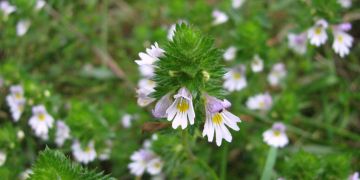It is found and used in Europe, North America, Western Asia, and Northern Asia. The name Euphrasia originates in Greece from the word for gladness. Other names for the plant are “Euphrasia” in English, “Augentröst” in German, and “Casse-lunette” in French. Alternative names, mainly in herbalism, are Augentrostkraut, Euphrasiae herba, Herba Euphrasiae and Herbe d'Euphraise. The first mention of this herb is in 1305 in Gordon's Liticium Medicina.
The Euphrasia Plant
This annual herb grows two to eight inches tall with deep cut leaves and white or purple blooms that have yellow variegations. It is a member of the Figwort family of plants. It has a bloom season between July and September. There are opposite branches on an erect stem with leaves that will be up to 1/2 an inch long. Flowers are on terminal spokes with a two-lipped corolla. Seeds are in tiny flat capsules. It needs to be near grass to grow in a cultivated environment due to its parasitic nature.
What Parts Are Used
When the plant is in full flower stage, around July or August, a fluid extract is prepared. The plant is cut right about the root for preparation. It has several chemical compounds such as the tannin Euphrasia-Tannin acid, glucose, and mannite, which is a crystalline water-soluble sweet-tasting alcohol.
What Eyebright Does for the Eyes
This plant has a long history of use for eye problems, hence the name of Eyebright. When used appropriately, eyebright will reduce inflammation in the eye caused by blepharitis (inflammation of the eyelash follicles) and conjunctivitis (inflammation or infection of the membrane lining the eyelids). It can be used as an eyewash, as eye drops, or plant infusions taken internally for ophthalmic use.
What Eyebright Does for the Respiratory Tract
It is used as an anti-inflammatory for hay fever, sinusitis, upper respiratory tract infections, and catarrh (inflammation of the mucous membranes). As an astringent, it is used for dry congestion. There is an herbal smoking mix of the dried herb that is used for bronchial colds. It also can be used for seasonal allergies and other nasal irritations.
What Eyebright Does for Skin Wounds
As an astringent, the herb is used to aid in the healing on skin wounds. It is made into a poultice and used on the wound topically. It can also be used to treat acne and aid in skin inflammation. A cold eyebright poultice can help tighten skin.
Dosages
Traditionally, an adult dosage of eyebright is two to four grams of the herb, dried, up to three times a day. This can be in tea form with 5 ounces of boiling water. For eye drops, one to five times a day of a single drop appears the norm. These eye drops, when used for pinkeye, can be taken for three to seventeen days.
Preparations
Eyebright is able to be purchased in the forms of teabags, loose dried leaves, capsules, liquid, tablets, powder, tincture, and oil. It is also in several over-the-counter and online herbal supplement combinations. It is an ingredient in some cough and cold remedies, in skin lotions, acne medications, and other mixtures.





